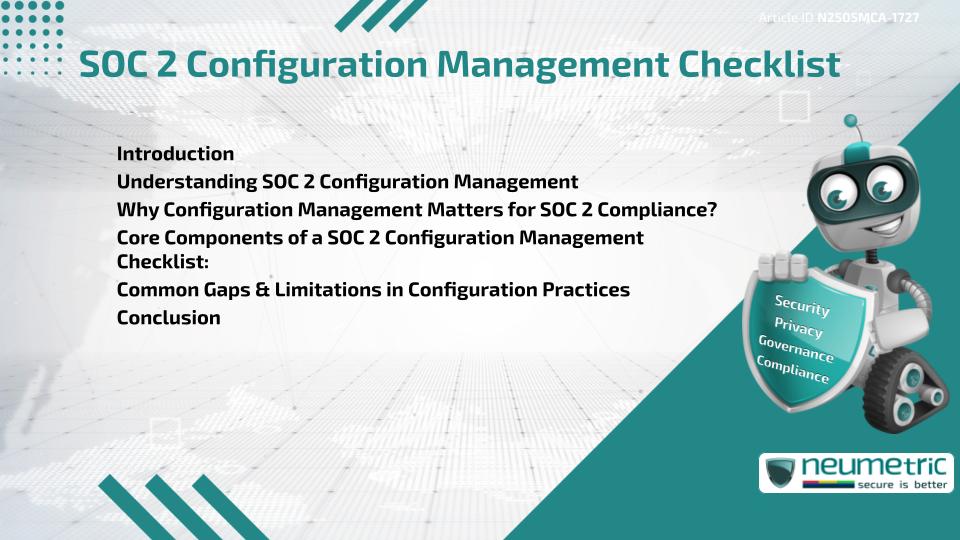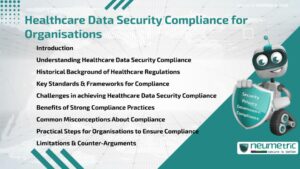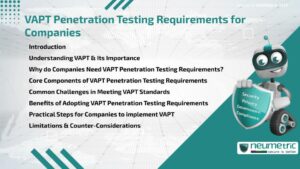Table of Contents
ToggleIntroduction
In today’s cloud-driven world, Software-as-a-Service [SaaS] providers must demonstrate robust security practices. One essential component of achieving System & Organisation Controls 2 [SOC 2] compliance is configuration management. This process ensures that systems are set up consistently, changes are controlled & unauthorised alterations are prevented. A well-structured SOC 2 configuration management checklist plays a key role in helping teams maintain secure & stable IT environments while satisfying audit expectations.
This article explores what configuration management means in the SOC 2 context, outlines key checklist elements & offers practical guidance for implementation.
Understanding SOC 2 Configuration Management
Configuration management in SOC 2 refers to the practice of defining & maintaining the secure state of hardware, software & system settings across your environment. It is a control requirement under the Security & Availability trust service criteria & supports continuous system reliability.
The SOC 2 configuration management checklist provides a documented path to follow, ensuring that changes to infrastructure do not introduce vulnerabilities or compliance issues. It helps enforce consistency & control across diverse systems, whether in physical, virtual or cloud-native setups.
Why Configuration Management Matters for SOC 2 Compliance?
Misconfigured systems are a leading contributor to many security breaches. An open port, outdated software or incorrect system permission can be exploited by attackers. SOC 2 requires organisations to reduce such risks by standardising system configurations & validating them regularly.
Without a formal checklist, configuration drift—where systems gradually become inconsistent—can occur. This not only weakens security but may also cause failure during a SOC 2 audit. A SOC 2 configuration management checklist reduces that risk by enforcing routine checks & remediation actions.
Core Components of a SOC 2 Configuration Management Checklist:
Creating a strong configuration checklist means addressing multiple elements that affect infrastructure security. Here are the core components:
Asset Inventory & Classification
Start by identifying all technology assets. This includes servers, endpoints, cloud resources, network devices & software applications. Each item should be classified based on its sensitivity & importance to business functions.
Maintaining an accurate inventory ensures traceability & enables focused security controls.
Baseline Configurations & Standardisation
Every system type—whether a Linux server or a cloud container—should have a documented baseline configuration. This acts as a secure template that new systems must follow.
Baseline configurations reduce variability & provide a reference point for audits.
Change Management Procedures
All changes to configurations should follow an approval & documentation process. Unapproved updates, even minor ones, can create security holes.
Include the following in your checklist:
- Change request & review workflows
- Logging of configuration changes
- Rollback procedures for failed updates
Configuration Monitoring & Auditing
Use monitoring tools to automatically detect changes to configurations that were not planned or authorised. Alerting mechanisms should be in place for critical changes.
Periodic audits verify that configurations remain in their approved state, especially before an external audit.
Access Controls in Configuration Management
Only authorised personnel should be allowed to view or change system configurations. This prevents tampering & provides accountability.
Checklist items here include:
- Role-based access controls [RBAC]
- Least privilege enforcement
- Multi-factor authentication for system administrators
Common Gaps & Limitations in Configuration Practices
Even well-meaning organisations often overlook key areas:
- Relying too heavily on manual tracking
- Inadequate documentation of changes
- Lack of validation after configuration updates
- No rollback or backup strategy
A SOC 2 configuration management checklist helps close these gaps by embedding discipline & repeatability into IT operations.
Conclusion
A proper configuration management strategy is essential for both system integrity & SOC 2 readiness. It enables teams to prevent unauthorised changes, secure their infrastructure & reduce risk across the board. The checklist serves as a continuous reference point to ensure operational consistency, whether for an internal review or a third-party audit.
Takeaways
- A SOC 2 configuration management checklist helps organisations align system settings with security best practices.
- Key checklist areas include asset inventory, baseline configurations & access control.
- Consistency across systems improves audit readiness & operational efficiency.
- Automating audits & monitoring reduces manual errors & configuration drift.
- Addressing common gaps improves long-term security posture.
FAQ
What is included in a SOC 2 configuration management checklist?
It typically includes asset inventory, baseline settings, access controls, change tracking & automated auditing tools to maintain secure & consistent environments.
Why is configuration management important in SOC 2?
It ensures system settings are secure & standardised, reducing risk from unauthorised changes & enhancing overall audit readiness.
How often should configuration audits be performed?
Audits should be conducted at regular intervals, such as monthly or quarterly, depending on the criticality of the systems & regulatory requirements.
What tools can help implement a SOC 2 configuration management checklist?
Tools like Ansible, Chef, Puppet, & AWS Config can automate configuration tracking, baseline enforcement & policy compliance.
Can configuration management be manual?
Yes, but manual methods are error-prone. Automated systems provide better control, faster recovery from misconfigurations & stronger audit trails.
How does access control relate to configuration management?
Access control limits who can make changes to configurations, preventing unauthorised modifications that could compromise security or auditability.
Is configuration management only for production systems?
No, it should cover all environments—development, staging & production—to maintain consistency & reduce the risk of configuration drift.
What happens if we fail to maintain configuration consistency?
Inconsistencies may introduce vulnerabilities, increase the risk of outages & result in failed SOC 2 audits or security incidents.
Need help?
Neumetric provides organisations the necessary help to achieve their Cybersecurity, Compliance, Governance, Privacy, Certifications & Pentesting goals.
Organisations & Businesses, specifically those which provide SaaS & AI Solutions, usually need a Cybersecurity Partner for meeting & maintaining the ongoing Security & Privacy needs & requirements of their Clients & Customers.
SOC 2, ISO 27001, ISO 42001, NIST, HIPAA, HECVAT, EU GDPR are some of the Frameworks that are served by Fusion – a centralised, automated, AI-enabled SaaS Solution created & managed by Neumetric.
Reach out to us!





